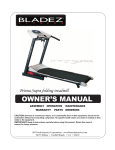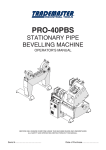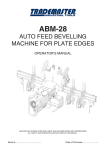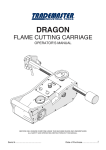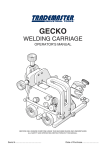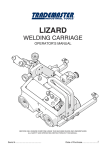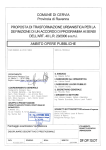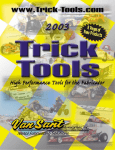Download PRO-10PBE User Manual.indd - Industrial Tool and Machinery Sales
Transcript
INDUSTRIAL TOOLS PRO-10PBE PORTABLE PIPE BEVELLER OPERATOR’S MANUAL BEFORE USE, ENSURE EVERYONE USING THIS MACHINE READS AND UNDERSTANDS ALL SAFETY AND OPERATING INSTRUCTIONS IN THIS MANUAL . Serial #............................................ Date of Purchase............................ TRADEMASTER PRO-10PBE PORTABLE PIPE BEVELLING MACHINE IMPORTED & DISTRIBUTED BY INDUSTRIAL TOOL & MACHINERY SALES INDUSTRIAL TOOL T F E W 18 BUSINESS ST YATALA QLD 4207 AUSTRALIA 07 3287 1114 07 3287 1115 [email protected] www.industrialtool.com.au WARRANTY TERMS In addition to any warranties or conditions implied by applicable Statute or Regulations, Industrial Tool & Machinery Sales warrants all of it’s products against defective workmanship and faulty materials for a period of twelve (12) months from the date of purchase, unless otherwise stated. At our option we will repair or replace, free of charge, any item on the condition that: • The complete machine or tool is returned, freight prepaid to ITM or one of it’s authorised service agents as directed by ITM, and is found to have a material or constructional defect. • The machine or tool has not been subject to misuse, neglect or damage by accident. • The fault is not a result of normal “wear and tear”. • Written permission has been received from ITM prior to commencement of repair. • Repairs, tampering or modification carried out by unauthorised personnel will void all warranty. • Consumable items such as cutting tools, pilot pins, saw blades, grinding wheels etc. are NOT covered by warranty. Our goods come with guarantees which cannot be excluded under the Australian Consumer Law. You are entitled to replacement or refund for a major failure and to compensation for other reasonably foreseeable loss or damage. You are also entitled to have the goods repaired or replaced if the goods fail to be of acceptable quality and the failure does not amount to a major failure. 2 TRADEMASTER PRO-10PBE PORTABLE PIPE BEVELLING MACHINE TABLE OF CONTENTS 1. 1.1. 1.2. Safety Instructions Application Safety Requirements -4-4-4- 2. 2.1. 2.2. 2.3. 2.4. 2.4.1. 2.4.2. 2.4.3. 2.5. 2.5.1. 2.5.2. 2.5.3. 2.6. Startup Design Equipment Included Destination and Setup Preparing for Operation Mounting Mandrel Into Pipe Selecting and Mounting the Tool Preparing for Operation Machine Startup Startup Feed Recommendations Cutting Tools Inspection, Adjustment, Maintenance, Service -6-6-7-7-8-8-8-9- 10 - 10 - 11 - 12 - 14 - 3. Technical Data - 14 - 4. 4.1. 4.1.1. 4.1.2. 4.1.3. 4.2. 4.2.1. 4.2.2. 4.2.3. 4.2.4. 4.2.5. 4.3. 4.3.1. 4.3.2. 4.3.3. 4.4. 4.4.1. 4.4.2. 4.4.3. 4.4.4. 4.4.5. 4.4.6. 4.5. 4.5.1. 4.5.2. 4.5.3. 4.5.4. 4.5.5. Optional Equipment Small Expander Set for Pipes of Internal Diameter of 38 - 86mm Equipment Included Destination and Setup Operation Method Range Increasing Set Technical Data Equipment Included Destination and Setup Adjusting PRO-10PB for Bevelling Pipes of Ø192-365 Operation Method Big Expanding Mandrel Technical Data Destination and Setup Operation Method Flange Facing Attachment Technical Data Equipment Included Adjusting PRO-10PB for Flange Facing Adjusting Slide Clearance Mounting Tool Holder and Cutting Inserts Operation Method Attachment for Oval Pipes Technical Data Equipment Included Mounting Attachment for Bevelling Oval Pipes Operation Method Adjusting Slide Clearance - 15 - 15 - 15 - 15 - 15 - 16 - 16 - 17 - 17 - 17 - 17 - 18 - 18 - 19 - 19 - 20 - 20 - 21 - 21 - 22 - 23 - 25 - 26 - 26 - 27 - 28 - 28 - 28 3 SAFETY INSTRUCTIONS READ OPERATOR’S MANUAL BEFORE YOU START TO WORK WITH THE MACHINE. 1. Safety Instructions Pipe beveller should be used only to applications stated in the manual. Using in other applications may lead to personal injury and machine damage. 1.1. Application The PRO-10PB is a pipe beveller designed for facing, bevelling, boring and/or sizing of pipes to prepare them for welding. These operations may be performed simultaneously or separately. The machine is designed for machining of carbon steel, stainless steel, aluminum alloys and coppernickel. Various interchangeable jaw blocks and ramps secure the machine into pipes of internal diameters from 84 mm to 269 mm (3.31’’ to 10.59’’) and from 38 mm to 392 mm (1.50’’ to 15.43’’) when used with optional equipment. 1.2. Safety Requirements Using beveller is not allowed if: 1. The wwperator has not read Operator’s Manual or has not completed proper occupational safety and health training. 2. Machine is to be used in applications not stated in Operator’s Manual 3. Machine is not complete or parts used for repair are not genuine. 4. Power supply specifications do not conform to those stated on rating plate. 5. Operator has not checked condition of machine, including power cord, control panel components and milling tools. 6. Machined pipe is not properly secured from falling or rolling. 7. Bystanders are present in immediate vicinity of machine. Detailed safety rules: 8. 9. 10. 11. 12. 13. 14. 15. 4 Before you start to work with machine, check condition of electric installation, including power cord and plug. Do not use power cord for other purposes, do not carry the machine by cord or yank it to disconnect the plug from socket. Connect machine only to installation equipped with safety circuit (earthing) protected with 16 A fuse for 230 V supply or 32 A fuse for 115 V. When used on building sites, supply the machine through separation transformer made in second protection class. Keep machine dry. Exposing it to rain or snow is prohibited. Ensure proper lighting in your worksite. Keep worksite clean. Cluttered worksite increases the risk of accidents. Wearing loose clothing or jewelry is prohibited. They may be caught in rotating machine parts. Avoid slippery surfaces. If this is impossible, use antislippery footwear. Keep power cords, cables, rope slings, belts etc. away from machine rotating parts. Do not use machine in vicinity of combustible fluids or gases. SAFETY INSTRUCTIONS 16. 17. 18. 19. 20. 21. 22. 23. 24. 25. 26. 27. 28. 29. 30. 31. 32. If possible, use clamps, vices, chains or belts to secure machined pipe. Avoid overloading. Machine and tools will operate much better if used under rated loads. Always use safety goggles and hearing protection. Keep bystanders or untrained personnel away from worksite. All observers must use eye protection. Do not remove chips formed during operation. Do not touch rotating parts of machine. Do not remove chips, adjust machine or check quality of machined surface during operation. Do not touch or change tool when machine is plugged into power supply. Tool must be fastened securely. Check if mounting screws are tighten securely. After changing the tool, check if keys or wrenches used for changing have been removed. Do not leave keys and wrenches behind after changing tool or machine adjustment. Do not use blunt or damaged tools. Use only tools recommended by manufacturer. After every use, remove all formed metal chips from machine. Perform all maintenance work and repairs only with power cord disconnected from power socket! Maintain machine and tools with care. Cover steel parts with thin grease layer to protect them against rust when not in use for a longer period. Remove tool bits from holders for safe transport and storage. Before every use, inspect machine to ensure it is not damaged and check whether machine operates properly and performs its intended function. Check whether any part is cracked and whether all parts are properly fitted. Make sure to maintain proper conditions that may affect machine operation. Avoid accidental turning on the machine. Do not hold or carry machine by pressing startup valve lever, do not place machine in a manner that makes pressing the lever impossible. If machine falls on a hard surface, from a height, is wet or has other damage that could affect technical state of machine, stop operation and immediately send machine to service centre for inspection. WARNING! SAFETY RULES MUST BE CLOSELY OBSERVED. 5 STARTUP 2. Startup 2.1. Design 1. 2. 3. 4. 5. 6. 7. 8. 6 Beveller Body Handle Feed Lever Spindle Disc Tool Holder Clearance Removing Set Expanding Mandrel Electric Motor STARTUP 2.2. Equipment Included PRO-10PB pipe beveller is supplied in metal box with complete standard equipment. The included equipment consists of: PRO-10PBE portable pipe beveller - 1 unit • Jaw block set (from no. 1 to 6) mounted on the bar - 1 unit • Metal box - 1 unit • Coolant container with nozzle - 1 unit • Size 24 socket key with handle - 1 unit • Size 4 Allen key - 1 unit • Size 5 Allen key - 1 unit • Size 6 Allen key - 1 unit • Tool container - 1 unit • Operator’s Manual - 1 unit • Container with cutting fluid - 1 unit 2.2. Destination and Setup Standard Expanding Mandrel Pipe diameter Pipe diameter Jaw block Ramp (mm) (in) no. 84-100 3.31 - 3.94 99 - 115 3.90 - 4.53 1 115 - 131 4.53 - 5.16 2 130 - 146 5.12 - 5.75 3 146 - 162 5.75 - 6.38 4 161 - 177 6.34 - 6.97 5 176 - 192 6.93 - 7.56 6 192 - 208 7.56 - 8.19 2 + 207 - 223 8.15 - 8.78 3 + 223 - 239 8.78 - 9.41 4 + 238 - 254 9.37 - 10.0 5 + 253 - 269 9.96 - 10.59 6 + Figure. Mandrel design (1 – Expanding mandrel; 2 – Ramp; 3 – Jaw block) 7 STARTUP 2.4. Preparing for Operation 2.4.1. Mounting Mandrel into Pipe • • • Choose adapter jaw blocks corresponding to given diameter (see 2.3, 4.3.2, 4.2.3). Screw jaw blocks to the mandrel and slide it into the pipe. Expand mounting jaw blocks into the pipe, rotating feed screw clockwise. Warning: To avoid damage of armed/complete expanding mandrel, expand jaw blocks into the pipe below anticipated surface level after milling. Figure. Mandrel position into the pipe (1 – Pipe; 2 – Jaw block; 3 –Surface after milling; 4 – Mandrel; 5 – Feed screw ) 2.4.2. Selecting and Mounting the Tool Warning: Using improper and/or not genuine tool bits may damage the machine and lead to loss of warranty. • • • • • • 8 Choose proper tool bits for milling. Mount tool bits for milling into sockets in position suitable to given type. When performing several operations simultaneously, like facing, bevelling and/or boring, mount boring tool bit in the front of bevelling tool bit. Mount tool bit into holder sockets, using size 4 Allen key. Cutting edge of the tool bit must be placed on the radial centerline of the head. Make sure all tool bits are mounted in the same direction as head rotation direction. STARTUP Figure. Mounting the tool bit (1 – Cutting edge; 2 – Clamping screw; 3 – Size 4 Allen key; 4 – Rotation direction) 2.4.3. Preparing for Operation • • • • Loosen the set screw. Loosening the spring causes enough clearance between insert and mandrel to the mount the machine on the mandrel. Slide the machine gently onto the mandrel until encountering resistance. Rotate the machine until the flat surfaces of the insert (placed inside the machine body) slide onto the mandrel surfaces. Slide the machine to the final resistant position. Rotate feed knob clockwise for at least 10 threads when the feed screw nut will engage with the mandrel. Warning: Operations mentioned above should be carried out very carefully, due to the resistant surfaces of the mandrel and machine socket being threaded. Forcing the machine or striking it while inserting may lead to damage of the mandrel thread or feed screw nut thread and subsequently prevent the machine from being mounted correctly and used. • Remove the clearance between the machine and mandrel. Removing Clearance Adjusting is necessary every time after the machine is mounted on the mandrel and always when radial clearance is present between the mandrel and machine. The clearance is displayed by vibration of the tool bits during milling. • Tighten the set screw until clearance is removed. • Turn the feed knob in both directions to make sure the screw is not too tight. • If necessary, loosen the screw once again and correct the pressure. • Tighten the lock nut. Figure Removing clearance (1 – Mandrel; 2 – Clamping insert; 3 – Body; 4 – Lock nut; 5 – Clamping screw) 9 STARTUP 2.5. Machine Startup READ OPERATOR’S MANUAL BEFORE YOU START TO WORK WITH THE MACHINE. IT IS OF UPPER MOST IMPORTANCE THAT POINT “1.2 SAFETY REQUIREMENTS “ IS READ THOROUGHLY 2.5.1. Startup • • • • • Check distance between the tool (tool bit) and face of the pipe at its highest point. The distance should be at least 3mm. Make sure once again that the ramp between tool bit and jaws or locking jaw blocks is correct to provide operation without collision. Connect the machine to power grid (see 1.2). Check if the proper rotation direction is set on the engine. Starting operation with improper rotation direction leads to damage of the tools and creates a risk for personnel in the vicinity. Rotate the POWER knob to maximum ”+” direction. It will enable motor working with maximum torque. Figure 6. Removing clearance (1 – Drive gear switch; 2 – Rotation direction switch; 3 – Main switch; 4 – Lock button; 5 – Speed adjustment knob; 6 – Torque adjusting knob) • • • • • 10 Press and hold engine main switch button. To lock the button in “on” position, press the lock button first. Rotate the feed knob clockwise to move the tool bit close to pipe face. The cutting starts when the first tool bit touches the pipe face. If the pipe face is not perpendicular, thus in the first phase of cutting the surface machined in single rotation will be small, limited to highest point of the pipe face. To avoid damage of the tool, apply small feed per rotation until the tool bit starts to cut the whole surface of the pipe face. To maintain the correct performance of the milling and to maximally extend life of the tool, adjust feed rate/milling speed to machined material by rotating speed knob and/or changing drive gear (changing drive gear can be performed only after the spindle is stopped). STARTUP Figure. Feed unit (1 – Scale; 2 –Feed lever) • Continue operation, rotating the feed levers clockwise until achieving the required geometry of the pipe face. The feed equals 0.11 mm per one pitch or 2 mm per one full rotation of the feed lever. • • • • • Stop removing metal chips and allow the head to rotate several rotations to finish the prepared surface. Release motor starting button to stop the machine. Separate the tool from machined surface to a minimum of 3 mm, rotating feed lever counterclockwise. Unscrew feed screw using size 24 socket wrench to loosen the mandrel located into the pipe. Remove machine from the pipe. Do not disassemble the mandrel! The machine and mandrel constitute the complete set and reassembling is not necessary. 2.5.2. Feed Recommendations • • • • Use very light feed for initial bevelling, until a continuous cut is established, particularly when pipes are cut with the torch or/and when the cut is not perpendicular to the axis. Use proper feed to obtain a continuous chip cut. If the feed is too light, chip has a form of a thin spring. If the feed is too heavy, cutting is more difficult and the chip is rough. Stainless steels susceptible to hardening during milling should be cut with sufficiently high feed to stay under hardened layer (0.08–0.15 mm/rotation). Never allow tool bit to slide and press the surface. Changing feed rate often minimizes chatter problem (if it appears). 11 STARTUP 2.5.3. Cutting Tools Using PRO-10PB pipe bevelling machine enables the following operations. Figure. Facing Figure. Bevelling Figure. “J” Bevelling 12 STARTUP Figure. Boring Figure. Internal Bevelling / Sizing 1. 2. 3. 4. 5. Working head Tool bit holder Tool bit Cutting edge Pipe 13 TECHNICAL DATA 2.6. Inspection, Adjustment, Maintenance and Service. To avoid accidents, the machine, power cords, joints and switches must be checked on a regular basis in case of possible damages. • • • • • • All parts should be cleaned and maintained with thin oil film. Use clean and pure oil with density according to SAE 10 (90SSU) or lower. If the PRO-10PB was used in reverse position, rotate it after every use to remove chips or other garbage accumulated on the working head. All repairs must be performed in service centre appointed by seller. Replace damaged parts of machine only with genuine ones. When ordering replacement parts, it is required to state the code (specific parts list available from seller or service centre) and machine type. 3. Technical Data 289 580 O 292 547 Power supply Motor power Internal diameter working range Pipe maximum outer diameter Material thickness Materials allowed Spindle rotational speed on I gear Spindle rotational speed on II gear Weight Noise level Ambient temperature range 14 110V AC / 50-60 Hz 230V AC / 50-60 Hz 1800 W 84-269 mm 274 mm up to 15 mm carbon steel, stainless steel, aluminum alloys, copper-nickels 12–28 rpm 41-96 rpm 31.5 kg Below 70 dB –20°C to +40°C OPTIONAL EQUIPMENT 4. Optional Equipment 4.1. Small Expander Set for Pipes of Internal Diameter of 38 - 86 mm. Part# 10/510 4.1.2. Destination and Setup Small Expanding Mandrel Pipe diameter (mm) Pipe diameter (in) Jaw block no. 38–47,5 1.50–1.87 – 47,5–57,5 1.87–2.26 I 57,0–67,0 2.24–2.64 II 66,5–76,5 2.62–3.01 III 76,0–86,0 2.99–3.39 IV Ramp – – – – – 4.1.3. Operation Method Operation method - see point 2.4 15 OPTIONAL EQUIPMENT 4.2. Range Increasing Set - Part# 10/550 Using range increasing set enables to mill pipes of internal diameters of Ø192 - 365mm. Before you start to work, read all contents of the manual, especially safety rules. 4.2.1. Technical Data O 372 294 Machined pipe diameters Rotating parts reach 16 Ø192 - 365 mm Ø372 mm OPTIONAL EQUIPMENT 4.2.2. Equipment Included The range increasing set to 365mm is supplied to the client in a metal box. Included equipment consists of: • Tool bit holder set to 365 – 1 unit • Jaw blocks set (from no. 7 to 12) mounted on the bar – 1 unit • Metal box – 1 unit • Size 4 Allen key – 1 unit • Size 5 Allen key – 1 unit is necessary in all cases. Because the “3” segment can not be last, for pipes in 223–251 mm (8.78–9.88’’) diameter range place it within “B” segment after dismounting links (Figure 12, Item 4) from connector (Figure 12, Item 3). 4.2.3. Destination and Setup Standard Expanding Mandrel Pipe diameter (mm) Pipe diameter (in) Jaw block no. 192 - 208 7.56 - 8.19 7 208 - 224 8.19 - 8.82 8 224 - 240 8.82 - 9.45 9 240 - 256 9.45 - 10.08 10 256 - 272 10.08 - 10.71 11 272 - 288 10.71 - 11.34 12 285 - 301 11.22 - 11.85 8 301 - 317 11.85 - 12.48 9 317 - 333 12.48 - 13.11 10 333 - 349 13.11 - 13.74 11 349 - 365 13.74 - 14.37 12 Ramp + + + + + 4.2.4. Adjusting PRO-10PB for Bevelling Pipes of Ø192 - 365 To machine pipes of outer diameters in Ø215-418 range, disassemble all three tool holders (5, see point 2.1). Remove all garbage from spindle disc (4) – make sure no chips remain. Mount tool bit holder set to pipes of Ø192-365 on the pipe beveller spindle disc (4). Arm the expanding mandrel (7) according to table from point 4.2.3. 4.2.5. Operation Method Operation method – see point 2.4. 17 OPTIONAL EQUIPMENT 4.3. Big Expanding Mandrel - Part# 10/540 Big expanding mandrel is used to mount PRO-10PB beveller into pipes of diameter from 126 mm to 392 mm. 4.3.1. Technical Data 18 OPTIONAL EQUIPMENT 4.3.2. Destination and Setup Big Mandrel + Standard Jaw Blocks Pipe diameter (mm) Pipe diameter (in) Jaw block no. 126 - 142 4.96 - 5.59 1 142 - 158 5.59 - 6.22 2 157 - 173 6.18 - 6.81 3 173 - 189 6.81 - 7.44 4 188 - 204 7.40 - 8.03 5 203 - 219 7.99 - 8.62 6 219 - 235 8.62 - 9.25 2 234 - 250 9.21 - 9.84 3 250 - 266 9.84 - 10.47 4 265 - 281 10.43 - 11.06 5 280 - 296 11.02 - 11.65 6 Ramp N/A N/A N/A N/A N/A N/A A A A A A Big Mandrel + Jaw Blocks of Milling Pipes Range Increasing Set Pipe diameter (mm) Pipe diameter (in) Jaw block no. Ramp 219 - 235 8,62 - 9,25 7 N/A 235 - 251 9,25 - 9,88 8 N/A 251 - 267 9,88 - 10,51 9 N/A 267 - 283 10,51 - 11,14 10 N/A 283 - 299 11,14 - 11,77 11 N/A 299 - 315 11,77 - 12,40 12 N/A 296 - 312 11,65 - 12,28 7 A 312 - 328 12,28 - 12,52 8 A 328 - 344 12,91 - 13,54 9 A 344 - 360 13,54 - 14,17 10 A 360 - 376 14,17 - 14,80 11 A 376 - 392 14,80 - 15,43 12 A 4.3.3. Operation Method Operation method – see point 2.4. 19 OPTIONAL EQUIPMENT 4.4. Flange Facing Attachment - Part# 10/520 The flange facing attachment is designed for the PRO-10PB pipe beveller. It enables facing of pipe flanges of diameters from 90mm to 508mm. The bumpers (mounted on the holder body) and the rack fixed to the milling set feed screw work together to allow feed to the tool. If the rack cooperates with one bumper, the feed is equal 0.33 mm/rotation. If the rack cooperates with two bumpers, the feed is equal 0.66 mm/rotation. Before you start to work, read all contents of the manual, especially safety rules. 4.4.1. Technical Data 397 185 124,3 Operating range Automatic feed Feed rate Maximum chip width Rotating parts diameter 20 Diameters from 90mm to 508mm 180.5mm 0.33mm or 0.66mm per rotation 5mm 569.4mm OPTIONAL EQUIPMENT 4.4.2. Equipment Included Flange facing attachment is supplied to client The included equipment consists of: • Milling set • Complete holder • M6x30 screw • M6x35 screw • M6x14 screw • Metal box • Size 13 ratcheting combination wrench • Size 3 Allen key • Size 4 Allen key • Size 5 Allen key • Torx T15 Allen key with lever • Cutting insert • Screw securing cutting insert • Tool container in metal box with complete standard equipment. – 1 unit – 1 unit – 3 units – 3 units – 3 units – 1 unit – 1 unit – 1 unit – 1 unit – 1 unit – 1 unit – 8 units – 2 units – 1 unit 4.4.3. Adjusting PRO-10PB for Flange Facing 1. Dismantle three tool bit holders from spindle disc. 2. Dismantle holder, unscrewing three M6x14 screws (4) with washers (3). 3. Mount flange facing attachment holder (2) to the body, using M6x14 screws (4) with washers (3). 1 5 5 2 3 4 21 OPTIONAL EQUIPMENT 4. Tighten up M8x40 clamping screws (5). 5. Mount milling set (6) on the pipe beveller spindle disc (1), using six M6x30 screws (7). 6. Mount expanding mandrel (8). 8 7 6 1 4.4.4. Adjusting Side Clearance 1. Loosen screws that mount the guide from adjusting screws side. 2. Move the slide to maximum outside position. 3. Tighten adjusting screws in such way to gently press the guide to slide. Tighten only screws located opposite the slide. 4. Gently tighten screws that mount the guide (rotate it according to torque 1.5–2.5 Nm). 5. Using supplied ratcheting combination wrench, move the slide to the middle position, rotating the feed screw. There should be no differences in resistance when moving the slide. 6. Gently tighten the remaining adjusting screws. 7. Move the slide through the whole length of the feed. Movement of the slide should be smooth and even. 8. Tighten up the screws mounting the guide and lock the adjusting screws with M8 nuts. 9. Check if the slide moves gently and evenly on the whole length of the feed. 10. If necessary, repeat the adjustment. Figure. Slide set adjustment (1 – Feed screw; 2 – Slide; 3 – Adjusting screws; 4 – Screws that mount the guide) 22 OPTIONAL EQUIPMENT 4.4.5. Mounting Tool Holder and Cutting Inserts Figure. Mounting the tool with standard rotation direction of the machine (clockwise) seen from operator side. Figure. Mounting the tool with inverse rotation direction of the machine (counterclockwise) seen from operator side. 1 – Cutting insert 2 – Cutting insert holder 3 – Holder clamp 23 OPTIONAL EQUIPMENT The arm for flange facing is equipped with two cutting inserts holders – external and internal. When the machine is used in the middle of the operating range, both holders can be used. When working in the upper, extreme operating range, the external holder should be used. Similarly, when working in lower operating range, use internal holder. Operating range dependent on cutting inserts holder Cutting inserts internal holder Ø90 – 451mm Cutting inserts external holder Ø147 – 508mm The arm for flange facing enables operation in both rotation directions of the PRO-10PB pipe beveller spindle. However, operating with left rotation direction is possible only in pipe beveller with the electric motor. Changing rotation direction in PRO-10PB standard pneumatic motor is impossible. To rearm the device for work with inversed rotation direction, unscrew the clamp holder and the inserts holder with supplied size 3 Allen key. Then mount them again, changing places as shown in Figure “Mounting the tool with inverse rotation direction...”. Remember that with standard rotation direction (clockwise when seen from operator’s side), the feed of tool is performed from the outside to the middle. After changing the rotation direction, the feed is performed from the middle to the outside. Milling Parameters Recommended Milling Depth Rough milling 0.5 mm Precise milling 0.25 mm Feed rate dependent on material and surface type Rough milling Precise milling 24 0.66 mm both bumpers are working 0.33 mm one bumper is working OPTIONAL EQUIPMENT 4.4.6. Operation Method The method of mounting beveller with the facing flange set into the pipe does not change. After mounting the machine, use supplied size 13 ratcheting combination wrench to move the slide into extreme external or internal position, depending on used cutting inserts holder. Move out both pivots of the bumpers. Rotate the feed lever, set milling depth to a maximum 0.5 mm from the highest point and then turn on the motor and start milling. WARNING! BEFORE STARTING THE MACHINE MAKE SURE THAT SIZE 13 RATCHETING COMBINATION WRENCH IS NOT LEFT BEHIND. CHANGING POSITION OF FEED LEVER DURING MILLING IS PROHIBITED. When facing of the pipe flange is finished, turn the motor off and after it stops rotate the feed lever counterclockwise (looking from operator’s side) to prevent damaging the cutting insert from the slide back to initial position. If the material is not removed from the whole flange face, repeat the above action. If the surface layer is removed from the whole flange area, perform finishing milling using only one moved out bumper mandrel with milling depth below 0.25 mm. 1 – Feed lever 2 – Bumper 3 – Slide 4 – Size 13 ratcheting wrench 25 OPTIONAL EQUIPMENT 4.5. Attachment for Oval Pipes - Part# 10/530 Attachment for oval pipes is designed for PRO-10PB beveller. It enables facing and bevelling of oval profile edges from 126 to 296 mm (depending on chosen mandrel configuration and ramps). The attachment can be mounted to PRO-10PB beveller easily and quickly instead of the standard one, and vice versa. Before you start to work, read all contents of the manual, especially safety rules. O550 4.5.1. Technical Data 245 644 Machined internal pipe diameters Rotating parts reach 26 126 - 296 mm Ø550 mm OPTIONAL EQUIPMENT 4.5.2 Equipment Included Oval pipe attachment is supplied to client in metal box with complete equipment. The included equipment consists of: • Bevelling set for oval pipes – 1 unit • Big expanding mandrel – 1 unit • Metal box – 1 unit • Ratcheting knob 1/2” – 1 unit • Size 8 flat key – 1 unit • Size 6 Allen key – 1 unit • Size 5 Allen key – 1 unit • Size 4 Allen key – 1 unit • Size 2.5 Allen key – 1 unit • Tool container – 1 unit 4.5.3. Mounting Attachment for Bevelling Oval Pipes To use the attachment for bevelling oval pipes, dismantle mandrel and tool holders. Then, mount cutting set (1) to PRO-10PB disc, using all eight M6x30 screws (3). Arm the big expanding mandrel in jaw blocks corresponding to required diameter (see point 2.3) and mount it according to the manual. 2 3 1 Pro10 PB 27 OPTIONAL EQUIPMENT 4.5.4. Operation Method 1. Read Operator’s Manual before you start to work with the machine. 2. Always use safety goggles during operation. 3. Mount PRO-10PB beveller properly into the pipe. 4. Tighten bumper screw to lock the tool bit holder. 5. Loosen guide screws and rotate spindle until the feed roller reaches the smallest diameter. 6. Tighten guide screws what will block the slide. 7. Mount the tool bit. 8. Unscrew the bumper screw. 9. Put the feed roller into the pipe. 10. Initially increase tension of the spring using supplied ratcheting key ½”. 11. MAKE SURE THAT NO KEYS ARE LEFT IN THE SCREW SOCKETS. 12. To avoid damage of the tool, it must bypass the highest point of machined flange during first rotation. 13. Start the motor. 14. If the pipe edge is not perpendicular to pipe axis, at the beginning the tool mills only small part of the edge during every rotation. 15. If the cutting is done improperly: a. Stop the spindle. b. Check tool bit condition. c. Increase tension of the spring that presses the tool holder. d. Start the engine and check the result of adjustment. 16. After the milling is finished, turn off the motor to stop the tool. 17. Release fixing mandrel and take out the PRO-10PB beveller from the pipe. 4.5.5. Adjusting Side Clearance Adjusting slide clearance should be performed in the same way as for the arm for flange facing (see point 4.3.4). 28 WIRING DIAGRAM 4.6. Wiring Diagram 29





























